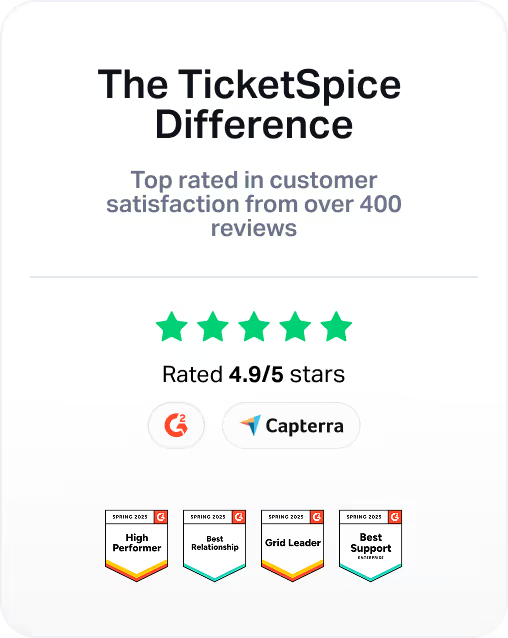The Ultimate Guide to Successful Event Planning
Successful event planning, at times, can feel like navigating a labyrinth of decisions and details. With the right guidance, though, your vision can materialize into a memorable reality. From defining your event's purpose to celebrating its success, each step in the planning process plays a pivotal role. With this comprehensive guide, you will navigate the intricate landscape of event planning with confidence and ease. Let's dive in and unlock the potential of your next gathering!
Step 1 - Define the Vision of Your Event
Think about what you want to achieve with your event on a big-picture level. Perhaps you’re seeking to facilitate community during a summer concert series or showcase local talent in the art show. Defining the vision of your event sets the tone and direction for successful event planning. It keeps every decision, from the venue and speakers to the ambiance and attendee experience, in alignment with your event goals. A vision is not just for event organizers; it should resonate deeply with your audience as well.
Identifying Purpose and Goals
Part of defining the vision of your event involves identifying your purpose and clarifying your goals. Before you lock down a location for a venue or fork over any hefty deposits, make sure you can answer these questions. Why are you having the event in the first place? What are your objective outcome goals? Whether you want to raise a certain amount of money, or increase brand awareness, the goals of your event will drive the direction of your planning.
Step 2 - Understand Your Target Audience
No matter what your specific event goals are, as an event organizer, you want your audience to leave satisfied and delighted. In order to do that, you have to understand who your audience is.
So, how do you get to know your attendees? First, map out what you know about your audience on a broader level. Understanding key demographic data empowers you to identify trends and niches that will improve your event offering. We recommend activating Contact Insights to gather information such as interests, education, and household stats, from publicly available records.
Crafting Your Event for Your Attendees
Once you’ve identified your audience on the macro level, put a magnifying glass on the micro details. Knowing whether your event is designed for young kids and their parents, or single twenty-somethings will help you decide the voice and style you use to communicate throughout the event.
If your event is a Renaissance Faire, for example, you can infuse the event copy with Old English and well-known Renaissance jargon. A picnic and slip ‘n slide event for kids, on the other hand, will have different objectives and a less formal tone of voice. Use the information you gather about your audience to deliver a curated, personalized event experience that delights your attendees.
Step 3 - Crafting a Comprehensive Budget
From the venue to the food to the entertainment, the amount of money you have to work with has a direct influence on nearly every facet of your event. And yet, far too often, event organizers will neglect to budget ahead, and instead, spend as they go. Avoid this financially fatal mistake by drafting a budget and determining how much you need to pull off the event you envision.
Financial Planning for Event Success
If you’re wondering where to begin, start with data from your past events. If this is a first-time event, find some data from other, similar events. From marketing to meals, make a detailed list of both fixed and variable expenses. Next, list out all of your projected revenue, from ticket sales, sponsorships, merchandise, etc.
As you develop your budget, examine whether the totals in each category accurately reflect your event values. If healthy food is a top priority of your farm event, then going big on alcohol while simultaneously lowballing the organic snack budget might send the wrong message.
Pro tip: Aim for ballpark accuracy on the larger expenses, such as the venue, but don’t agonize over hitting an exact bulls-eye. Your goal here is to kick off a working document. Keep this budget handy when it comes time to negotiate and commit. As a general rule, decide how much you want to allocate for this event and then plan for 10% more. Be it a costly weather change or simply inflation, you won’t regret having a margin.
Step 4 - Creating a Detailed Event Timeline
Similar to projects, events have a series of tasks and deadlines that require management in the lead-up time beforehand. While we touched on the relationship between timeline and size, earlier, there’s also a connection between timeline and budget.
A larger budget tends to offer a greater range of choices. It means you can afford to book venues during the pricier peak times and pay for rush services. A tight budget can require extra time for bargain hunting. Regardless of budget and size, however, make sure time is on your side!
Key Milestones and Deadlines
Outlining key milestones and deadlines help keep the workload manageable and the motivation high when the timeline is long. Using a collaborative project management tool, like Asana or Trello, will help ensure that people know what to do and when. For a visual layout of your timeline, try using an event timeline template or spreadsheet.
Step 5 - Assess Your Event Logistics and Needs
Planning a large event requires you to keep track of a staggering number of details. Give your mind a break from juggling, and take inventory of your event specifics with a checklist.
Resources, Staffing, and Equipment Checklist
- Time and date of event
- Ideal location
- Transportation to and from the venue
- Parking
- Lodging
- Staffing and volunteer roles
- Volunteers
- Audio/visual technology equipment
- Signage
- Post-event entertainment
- Catering and refreshments
- Post-event feedback
Step 6 - Securing the Perfect Venue
The ideal venue is one that meets the needs of your event and enables you to bring your event vision to life. If you book the wrong venue, you’ll be forced to build your event around the location, rather than the other way around. As you go about searching for your venue, consider the following list of factors.
Venue Selection Criteria and Booking Tips
Availability - Is this venue available when you need it? If not, is your event flexible?
Capacity - Does this venue have the capacity to accommodate an event of your size? If so, does it have space for all your attendees to gather in one place?
Aesthetics - Will this venue bring your theme or desired aesthetic appeal to life?
Location - Does the broader location, outside of the venue itself, meet the needs of your event? If you’re hosting a few hundred people from all over the country, consider factors such as airport proximity, post-event entertainment, food availability, and public transportation.
Technology - Can the venue provide sufficient technology for the planned audio/visual of the event and live stream? This is especially important for events such as concerts or films that are centered around the presentation component.
Drawing from the list above, write a venue Request for Proposal (RFP). Include as many relevant details as you can, including your objectives, budget, and event requirements. As you sift through the proposals and quotes, keep your event checklist by your side. Compare your categorized budget with the costs and offerings in the venue package. Does the total venue cost allow you to stay within your budget barriers?
We recommend keeping track of the factors in a pro/con list, a spreadsheet, or an online venue sourcing tool. Pay attention to your experience with the customer service team, too; consider it a preview of what’s to come if you decide to choose them.
Step 7 - Implement Dynamic Event Marketing Strategies
Developing a marketing strategy for your event is crucial for generating attendance and driving engagement among attendees. Not to mention, it’s a great way to keep your attendees informed.
Promotion Tactics to Reach Your Audience
Start by identifying your target audience and understanding their preferences and interests. Next, craft compelling messaging and visuals that resonate with your audience and convey the value of attending your event. Utilize various channels such as social media, email marketing, and targeted advertising to reach potential attendees where they are most active. In the lead-up to the event, create a buzz by posting regularly on your social media channels. Take advantage of email, a marketing powerhouse, and send out regular drips, newsletters, or promotional videos.
Engage with influencers or industry partners to expand your reach and credibility. Additionally, leverage strategies such as discount codes, referral programs, and early bird specials, to incentivize ticket sales and encourage word-of-mouth promotion.
Step 8 - Foster Engagement Throughout Your Event
One of the many measures of event success is the level of attendee engagement. Engaged attendees tend to learn more and make more connections. A good engagement strategy starts with knowing your attendees. Start by revisiting the audience information you gathered earlier and consider event components that will resonate with them specifically. Below are three different types of event engagement and interactive elements for each.
Attendee Engagement with Event Organizers
Before and during an event, attendees will contact event organizers for countless reasons—logistical questions and special requests, to name a few. Show your attendees that they matter by making yourself available to help them when they need it.
Attendee Engagement with Sponsors
If you want your sponsors and attendees to hit it off, don’t have to leave their encounters up to chance. Strategically design the setup of your event flow to help attendees and sponsors connect.
Attendee Engagement with Other Attendees
From networking to new friendships, meaningful connections between attendees can leave a positive impact on their entire event experience. Whether it’s group games at a fair, or an icebreaker at the banquet, think about interesting ways to facilitate connection between your attendees.
Pro tip - Kick off attendee engagement on social media and over email before the event begins; then keep it rolling throughout the event.
Step 9 - The Post-Event Process: Reflect and Celebrate
Finally, after the event is over, soak in the accomplishment and celebrate. And then, before you toss out your event materials, take some time to reflect.
Did you consider the event a success? Why or why not? What would you have done differently? Take the attendee’s opinions into account as well. What were their biggest wins and toughest challenges?
Analyzing Success and Gathering Feedback
Gather as much information and feedback as you can. The takeaways from this year’s event can provide valuable insight to help inform next year’s event.
Alas, with this guide by your side, you’re ready and equipped to hit the ground running with your event planning. Have more questions? Don’t hesitate to reach out.
We’re here to help you have the best event ever!
— The TicketSpice Team





















.jpg)